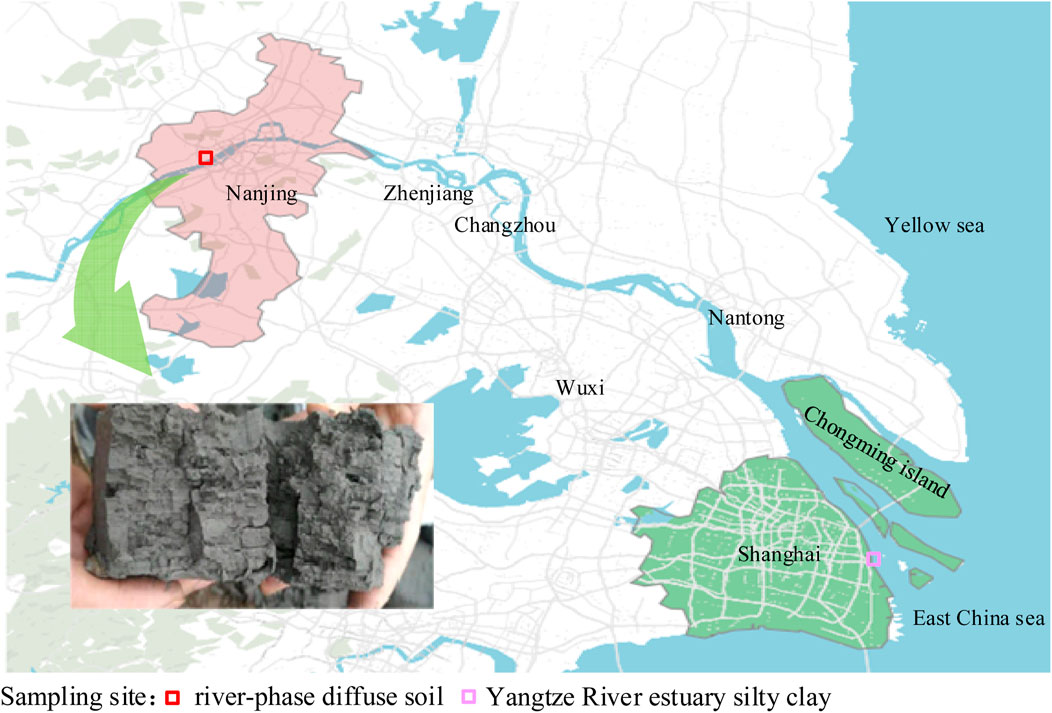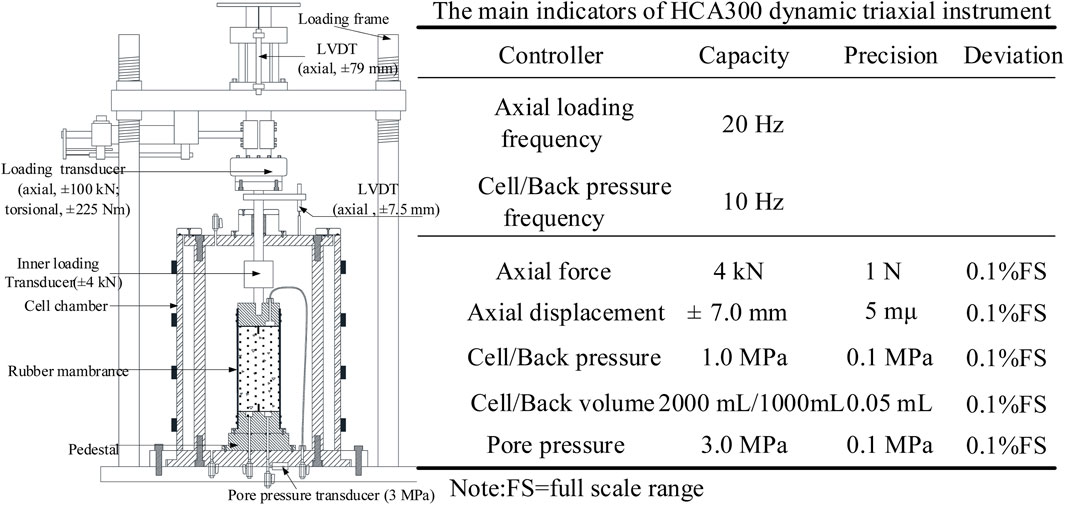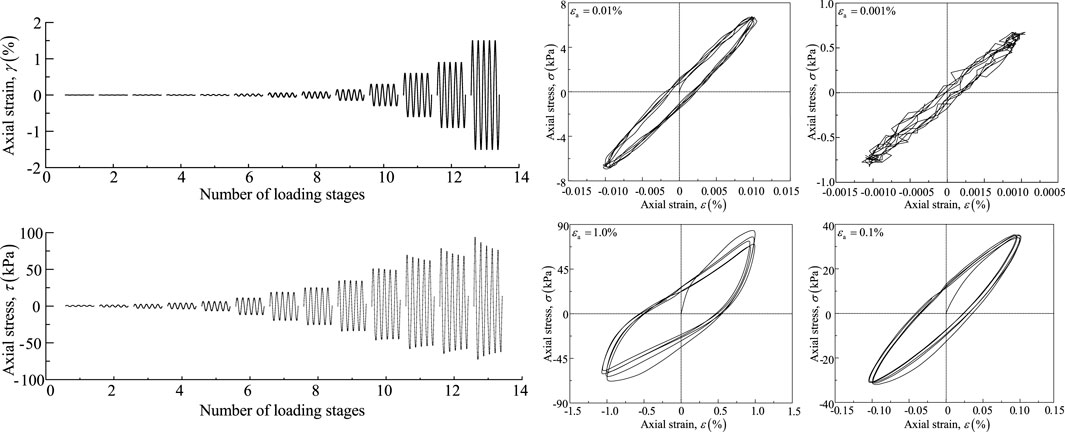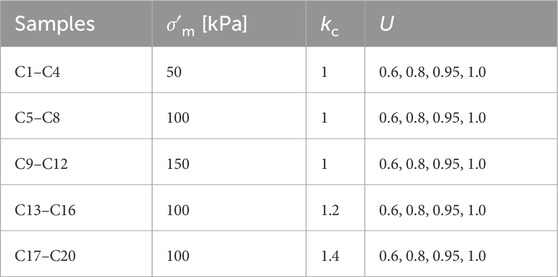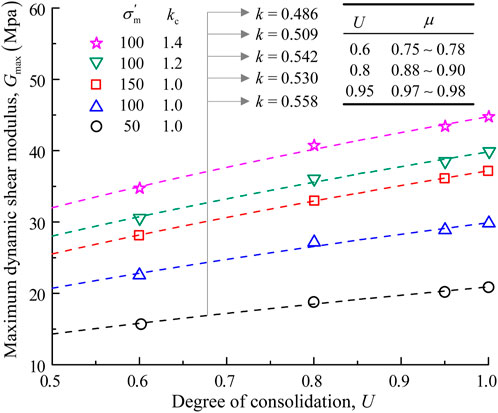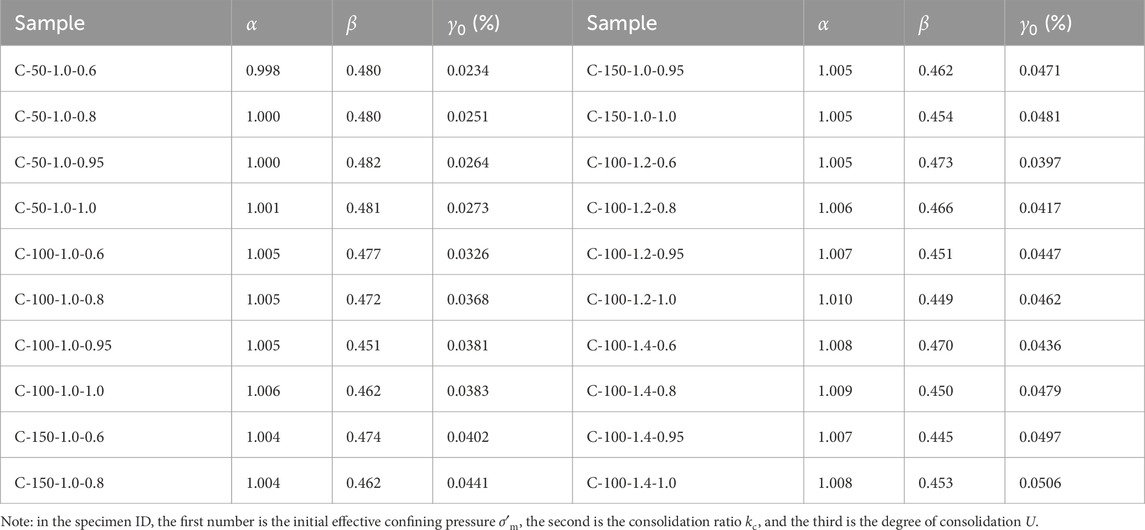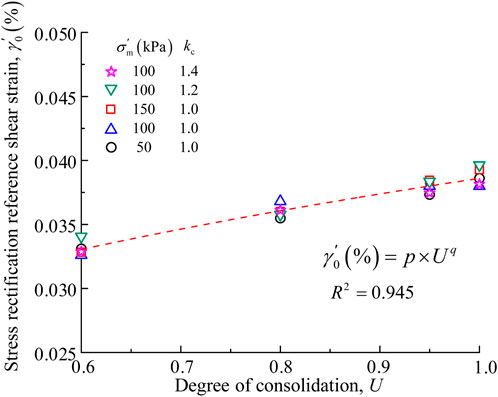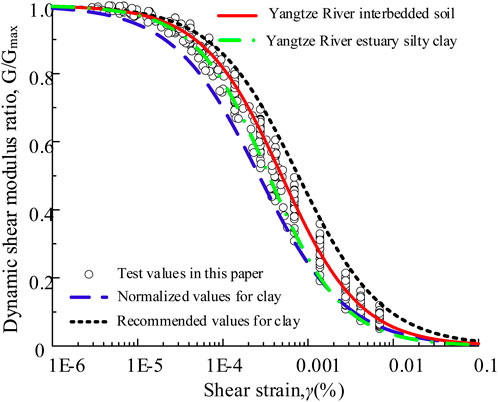- 1Zhejiang Institute of Communications Co., Ltd., Hangzhou, China
- 2China Nuclear Power Engineering Co., Ltd., Beijing, China
- 3Institute of Geotechnical Engineering, Nanjing Tech University, Nanjing, China
- 4School of Civil Engineering, Sanjiang University, Nanjing, China
To explore the characteristics of the dynamic shear modulus of river-phase (as opposed to estuarine) floodplain interbedded soil, undisturbed interbedded soil from the floodplain of the Yangtze River in Nanjing was subjected to strain-controlled cyclic triaxial tests to investigate how the initial effective confining pressure (σʹm), consolidation ratio (kc), and degree of consolidation (U) influence the maximum dynamic shear modulus Gmax and the dynamic shear modulus ratio G/Gmax. The results show that for this soil, G decreases with increasing strain amplitude, and for a given strain amplitude, G increases with increasing σʹm, kc, and U. Compared with soil from the Yangtze estuary, kc has a greater effect on Gmax of the floodplain interbedded soil. Finally, a modified Martin-Davidenkov model is proposed for predicting G/Gmax of river-phase floodplain interbedded soil under different σʹm, kc, and U.
Introduction
River-phase (as opposed to estuarine) floodplain soil is a typical example of the interbedded soil that is found in deltas, coastal regions, river floodplains, and lakes. In the floodplain of a river (Li et al., 2014; Tankiewicz, 2016; Boulanger and DeJong, 2018; Bucci, Villamor, and Almond, 2018; Beyzaei et al., 2020) the annual alternation between dry periods and ones when water is abundant causes the sediment and organic matter content of the water to change periodically, which also leads to similar cyclic variations in the hydrodynamic conditions. Consequently, the sediment exhibits differences in composition, thickness, particle size, and color, creating a unique and intuitive stratified structure. This process repeats numerously over time, leading to alternating, regular, and repetitive deposits of sandy soil and clayey soil.
Many underground structures near rivers and in coastal cities are in interbedded soil. Also, the foundations of coastal harbors and bridges often penetrate interbedded soil, and numerous marine engineering activities involve such soil. Studies have shown that stratified sites have obvious special characteristics in terms of the deformation of foundation supporting structures (Wan et al., 2022a), the stability of tunnel excavation and slopes, and the site liquefaction resistance (Beyzaei et al., 2018; Boulanger et al., 2019; Tasiopoulou et al., 2019; Beyzaei et al., 2020; Ecemis, 2021; Zhou et al., 2021).
Various scholars have conducted tests to determine the static and dynamic characteristics of interlayered soil. Tankiewicz (2015) conducted static triaxial tests on interbedded soil, with the observed failure modes revealing pronounced strength anisotropy and with considerable variability noted in the sample failure modes and shear strength values; also, the permeability and shear strength anisotropy of the interbedded soil surpassed those of many other soil types. Ma et al. (2019) conducted a series of ring shear tests on remolded overconsolidated soft interlayers, investigating the influence of remolded water content and consolidation stress on shear behavior under drained conditions. They found that water content can weaken the shear strength of soft interlayers, with cohesion being more sensitive to changes in water content compared to the friction angle; also, consolidation stress is an important factor influencing the strain-softening and strain-hardening behaviors of soft interlayers. Via extensive cyclic triaxial testing, Duong et al. (2016) explored how water content and fines content affected the resilient modulus of interlayer soil sampled from a railway substructure in France. The conclusions indicate that under unsaturated conditions, soil with high fines content exhibits a higher resilient modulus because of the influence of capillary suction. However, as the soil approaches saturation, fine particles negatively affect the resilient modulus. This suggests that protective drainage measures must be implemented for interlayer soil when its mechanical performance is satisfactory under unsaturated conditions but unsatisfactory under saturated conditions. Studying the mechanical properties of soil via techniques such as X-ray diffraction (XRD), energy-dispersive X-ray analysis (EDXA), and scanning electron microscopy (SEM) offers a multifaceted advantage. These methods provide precise information on mineral composition, elemental distribution, and microstructure, offering crucial support for a comprehensive understanding of the chemical and mechanical properties of soil. Sun et al. (2022) used XRD, EDXA, concentration monitoring, triaxial compression tests, unconfined compressive tests, and SEM to investigate the mineral composition, mechanical properties, and microstructure of weak interlayers in various acidic environments. The results showed that the pH value of the solution and the immersion time were significant factors influencing the undrained strength of the samples. Moreover, as the immersion time increased, microscopic structural parameters showed a decrease in the area of mineral particles and a simultaneous rise in the pore ratio. These microstructural changes observed in images and parameters were consistent with the macroscopic physical and mechanical properties of the samples. The interlayers can be as thin as few millimeters, and conventional in situ investigation techniques such as CPT and sonic borings fail to characterize the laminar structure (Beyzaei et al., 2020). To address this challenge, Tankiewicz (2016) conducted a thorough investigation using high-quality samples. Through the application of SEM and computed microtomography, intricate 3D models were reconstructed, unveiling the detailed nature of the varved clay structure. Furthermore, the mechanical properties of individual layers were scrutinized at the layer-thickness scale using nanoindentation (Tankiewicz, 2018).
The dynamic shear modulus (DSM) is important for evaluating the response behavior of soil under dynamic loads. In-depth research on the DSM helps to accurately predict the behavior of soil under different dynamic conditions, providing effective guidance and an evaluation basis for earthquake engineering, infrastructure construction, and soil–structure interaction. Geotechnical assessments based on established knowledge of non-interbedded soil can lead to confusion in practice. For instance, conventional liquefaction assessment procedures predicted site liquefaction that did not occur during earthquake events (Beyzaei et al., 2020; Ecemis, 2021). Challenges have also emerged in predicting the stability and consolidation behavior of embankments (Ladd and Foott, 1977) and estimating the side resistance of drilled shafts (Mackiewicz and Lehman-Svoboda, 2012). Consequently, establishing a distinct dynamic evaluation procedure for interbedded soil becomes imperative, especially for that in the floodplain of the Yangtze River, whose dynamic properties remain poorly understood.
Based on the aforementioned studies, this paper investigates the characteristics of the DSM (G) of interbedded soil in the floodplain of the Yangtze River under different values of the initial effective confining pressure (σʹm), consolidation ratio (kc), and degree of consolidation (U). The degree of consolidation U is an important parameter for evaluating the soil consolidation level, which directly affects the bearing capacity and deformation characteristics of the soil body. For example, in bridge construction, the degree of consolidation U of the riverbed soil needs to be evaluated first to ensure that the soil body has sufficient support to carry the weight of the bridge. Similarly, in high fill projects, by adjusting the degree of consolidation of the fill, settlement can be effectively controlled to ensure a smooth road. The use of U as an influencing factor reflects the effect of stress history on the dynamic properties of the soil in this interlayer, and also effectively reduces the consolidation time and improves the testing efficiency, which is very important in the context of the increasing demand for testing of geodynamic parameters.Considering U as an influencing factor reflects the influence of stress history on the dynamic properties of this interbedded soil while also effectively shortening the time used for consolidation; this improves the testing efficiency, which is very important given the increasing demand for testing the dynamic parameters of soil.
Test program and procedures
Test material
Undisturbed river-phase floodplain interbedded soil (FIS) is the main stratum for urban subsurface space development (Wan et al., 2022b). The soil samples tested in the study reported herein were obtained from the Central Business District of Jiangbei New District in Nanjing, China, as shown in Figure 1. The original river-phase FIS is gray-brown in appearance, with obvious horizontal stratification and sand sandwich structure, which is typical of river-phase FIS. The specific gravity (Gs), natural water content (w0), and natural wet density (ρ0) were determined according to D2216 (ASTM, 2019), D854 (ASTM, 2014), and D1556/D1556M (ASTM, 2015), respectively, and the natural density of the samples was 1.76 g/cm−3, the water content was 42.06%, the specific gravity was 2.71, the initial void ratio was 1.19, and the plasticity index was 17.18.
Test apparatus
In this study, multi-stage strain-controlled cyclic triaxial tests were conducted using the HCA-300 multifunctional cyclic triaxial instrument developed by GCTS, which can perform conventional static/cyclic triaxial tests and synchronous coupled bidirectional vibration loading torsion shear tests. The HCA-300 cyclic triaxial instrument and its main technical indicators are shown in Figure 2. The system hardware comprises a test platform, a pressure control cabinet, a computer, an acquisition system, a hydraulic source, and a vacuum pump; the system software comprises a digital servo controller and the GCTS CATS software. The HCA-300 cyclic triaxial instrument uses electro-hydraulic servo closed-loop control, which allows direct testing of the axial stress σd and axial strain ε of specimens. During cyclic loading, the σd values of a specimen are picked up by the built-in small-range axial force transducer, and the ε values are picked up by the small-range LVDT displacement transducer. See (Chen et al., 2019) for more details about the HCA-300 system.
For a cylindrical specimen, the shear stress τ and shear strain γ in the 45° plane of the specimen during loading are calculated as Equation 1:
where ν is Poisson’s ratio; for the in situ interbedded soil of the Yangtze River floodplain, we take ν = 0.42 (Zhuang et al., 2020). In the equivalent linear dynamic viscoelastic ontological model, the shear modulus is calculated as Equation 2 (D3999/D3999M-11 ASTM, 2013)
and the typical strain, stress, and strain–stress time-dependent curves are shown in Figure 3.
Test program and method
To investigate how G of FIS vary with consolidation degree U, five sets of tests with different U were performed according to the test program given in Table 1. The test steps were as follows. 1) Make the in situ FIS sample into a solid cylindrical specimen that has a standard size of 50 mm × 100 mm and is saturated. 2) Install the specimen into the base of the instrument, connect the top with the displacement transducer and the driving device, and close the pressure chamber. 2) After installation and according to the test conditions of the specimen, apply confining pressure to achieve different degrees of consolidation, with consolidation being completed after reaching the pre-set U. 4) The specimen is subjected to strain-controlled cyclic loading, with the amplitude of axial strain increasing in steps from 1 × 10−5 to 1 × 10−2. Each level of cyclic loading was five cycles with a frequency of 0.5 Hz.
Control methods for consolidation degree
Figure 4 shows the time histories of the axial displacement of completely consolidated FIS under different consolidation conditions. These axial displacement curves are then normalized to obtain the consolidation degree as a function of time (t), as shown in Figure 5. As can be seen, the U development trend is insensitive to the initial stress conditions, and U can be transformed into a function of the consolidation time t. Referring to the universal expression for the average consolidation degree of a soft clay foundation (Martin and Seed, 1983), the relationship between consolidation degree and time is fitted to obtain an exponential function of the form as Equation 3
where k and b are the shape coefficients of the curves. This is how U was controlled in the present study. The reference intervals for the consolidation time for different values of U are given in Figure 5, and as can be seen, the consolidation time used for the specimens is greatly reduced as U decreases.
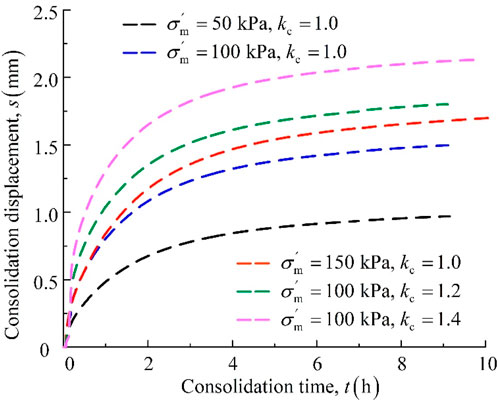
Figure 4. Consolidation displacement curves of Yangtze River floodplain interbedded soil (FIS) under different consolidation conditions.
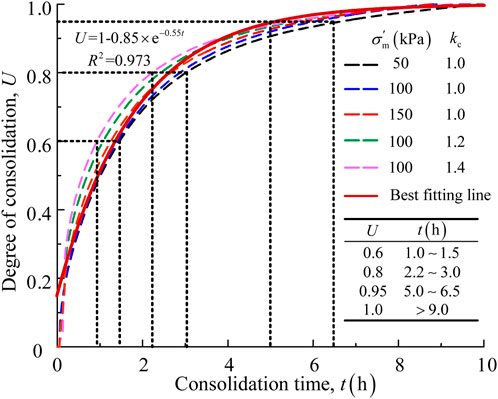
Figure 5. Consolidation curves and fitting for Yangtze River FIS under different initial stress conditions.
Test results and analysis
Effect of initial consolidation conditions on dynamic shear modulus
Figure 6 shows the distribution of the DSM G of the undisturbed FIS over a wide range of shear strain γ under different values of U. As can be seen, γ plays an important role in the development of G: for given U, each specimen exhibits decaying G with increasing γ. Also, for given γ, G increases with increasing U, which indicates that the larger the value of U, the greater the cementation degree between soil particles and the more stable the particle fabric, which contribute to greater stiffness for resisting shear deformation. In addition, comparing among the subplots in Figure 6 reveals the interesting phenomenon that increasing σʹm or kc results in G increasing more for a given increase in U.
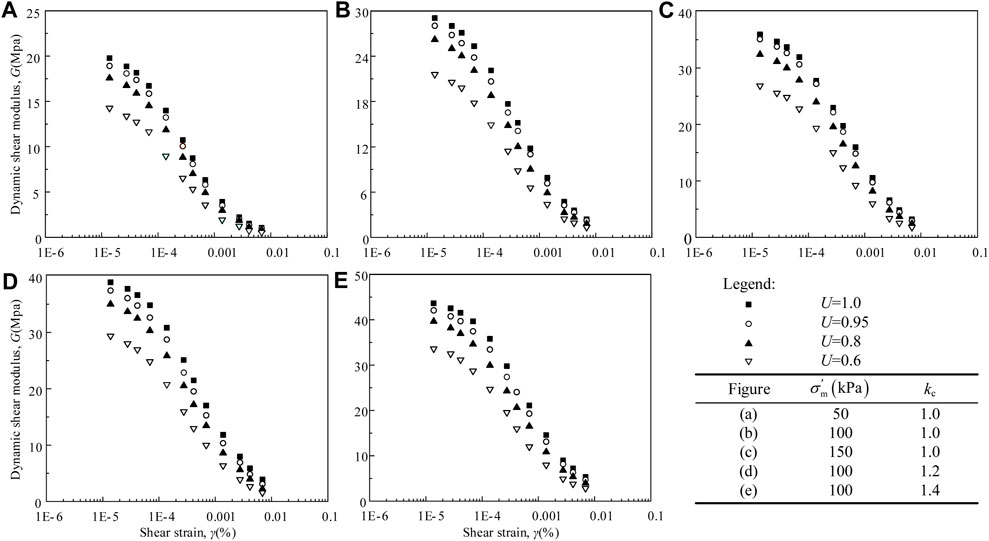
Figure 6. Test results for Yangtze River FIS with different degrees of consolidation. (A) σʹm = 50 kPa and kc = 1.0; (B) σʹm = 100 kPa and kc = 1.0; (C) σʹm = 150 kPa and kc = 1.0; (D) σʹm = 100 kPa and kc = 1.2; (E) σʹm = 150 kPa and kc = 1.4.
Effect of initial consolidation conditions on maximum dynamic shear modulus
The maximum DSM Gmax is the DSM when the strain percentage is less than 10−5, in which case the soil is considered to be in a purely elastic state. and so in this study Gmax was obtained using the extrapolation method at 0.0001% strain (Hardin and Drnevich, 1972). Figure 7 shows the variation of Gmax with U in the FIS with different values of σʹm and kc. It is obvious that Gmax is closely related to U: it increases with increasing U, and the data suggest an exponential correlation between Gmax and U. Also, the growth rate of Gmax with increasing U is insensitive to σʹm or kc. The proposed relationship between U and Gmax for FIS under different initial stress conditions is described as Equation 4
where A1 and k are fitting parameters. The coefficient A1 equals Gmax when U = 1, and the stress exponent k describes how U affects the growth rate of Gmax. Regression analysis suggests fixing k at 0.5 for different σʹm or kc. To estimate Gmax empirically under different U, those values are denoted as Gmax,U, and Gmax for U = 1 (100%) is denoted as Gmax,100%. Then Gmax,U is determined as Equation 5
where μ is the Gmax reduction coefficient. Figure 7 gives the recommended values of μ for FIS with different values of U for engineering applications.
Expression for and parameters of dynamic shear modulus ratio
To characterize quantitatively the variation of the nonlinear and hysteretic characteristics of river-phase floodplain soil at different U, the three-parameter Martin–Davidenkov model (Hardin and Drnevich, 1972) is selected to fit the relationship between G/Gmax and γ as shown in Equation 6
where α, β, and γ0 are best-fit parameters that control the shape of the G/Gmax–γ curve concerning the soil properties; γ0 is commonly known as the reference shear strain and is generally taken to be the value of γ0 at G/Gmax = 0.5.
As shown in Figure 8, U has a significant effect on G/Gmax. For a given strain amplitude, G/Gmax of the FIS increases with increasing U; i.e., the Yangtze River FIS presents stronger nonlinear characteristics as U increases. Also, for given U, the G/Gmax–γ curve rises with increasing σʹm or kc.
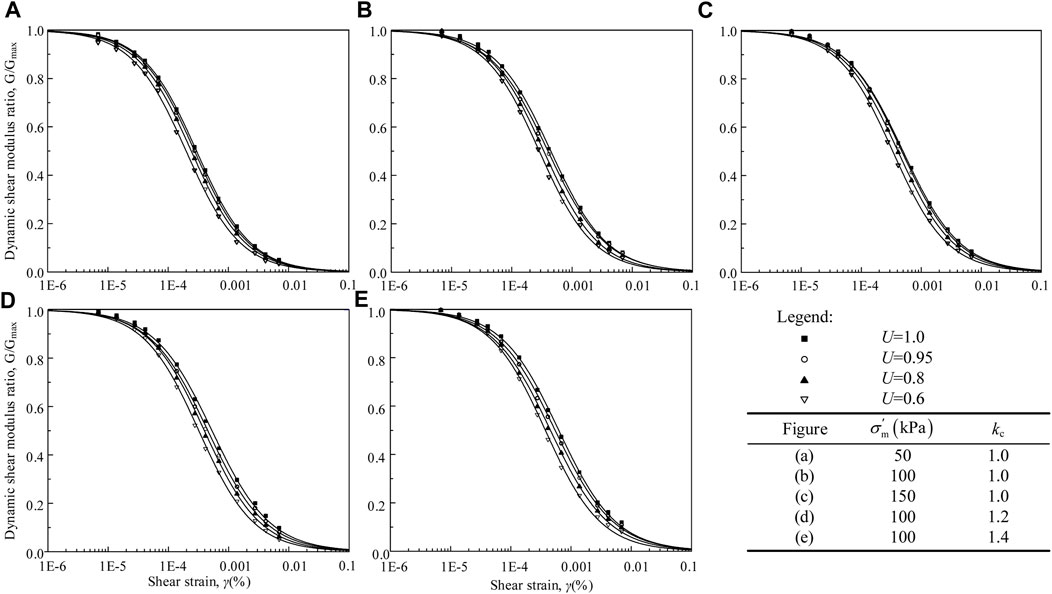
Figure 8. Relationship between G/Gmax and γ for Yangtze River FIS with different degrees of consolidation. (A) σʹm = 50 kPa and kc = 1.0; (B) σʹm = 100 kPa and kc = 1.0; (C) σʹm = 150 kPa and kc = 1.0; (D) σʹm = 100 kPa and kc = 1.2; (E) σʹm = 150 kPa and kc = 1.4.
Table 2 lists the values of the fitting parameters α and β for all the tested soil samples. The values of α range from 0.998 to 1.010 and those of β range from 0.445 to 0.482, which indicates that U has little effect on α and β. Therefore, for the Yangtze River FIS, α and β can be regarded as 1.0 and 0.47, respectively. Figure 9 shows the variation of γ0 with U under different σʹm and kc. As can be seen, for given σʹm and kc, γ0 increases with increasing U, and for given U, γ0 increases with increasing σʹm and kc. To quantify the relationship between U and γ0, the latter is normalized by considering the effects of σʹm and kc and is expressed as Equation 7
where n and m are related to the soil properties and are taken herein as n = 0.5 and m = 0.84, and Pa = 100 kPa as the value of standard atmospheric pressure. Figure 10 shows the relationship between γʹ0 and U, which as can be seen is a power law of the form as shown in Equation 8
where p and q are the fitting parameters, with p = 0.0436 and q = 0.7468.
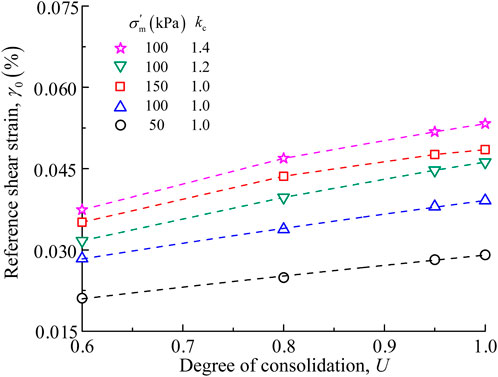
Figure 9. Relationships between consolidation degree U and reference shear strain γ0 under different values of σʹm and kc.
Figure 11 compares G/Gmax of the present FIS with that of silt clay from the Yangtze estuary (σʹm = 50∼200 kPa), as well as recommended values given by Yuan et al. (Shun et al., 2004) and normalized values given by the China Earthquake Administration (GB, 1999). As can be seen, the distribution range of the G/Gmax–γ curves for the FIS is within the statistical range of the recommended and standardized values for clayey soil. Compared with the Yangtze estuary silty clay, the FIS decays less rapidly and has larger G/Gmax at large strain, which indicates that the nonlinear properties of the FIS in the Yangtze River are weaker than those of the silty clay at the Yangtze estuary. Overall, the empirical equations given herein can be used for predictions regarding the FIS in the Yangtze River.
Conclusion
In this study, the characteristics of the DSM G of river-phase FIS with differing consolidation degree U were investigated, and the variations of the maximum DSM Gmax and the normalized DSM ratio G/Gmax with different U were analyzed. The main conclusions are as follows.
Under different values of the consolidation ratio, the development of U of Yangtze River FIS with consolidation time is almost the same. A quantitative method for relating U and the consolidation time was established and gives the corresponding reference time.
The Yangtze River FIS with different U shows nonlinear characteristics of “low shear modulus” in the strain range of 10−5 to 10−4. As the shear strain γ increases, the DSM G decreases, and at different strain levels, G increases with increasing U.
For Yangtze River FIS, Gmax is affected by U and increases gradually with increasing U. Taking the Gmax value at a consolidation degree of 100% as a reference, the reference range for the reduction coefficient μ of Gmax of soft soil in the Yangtze River floodplain corresponding to different consolidation degrees is provided.
Finally, the G/Gmax–γ curves of Yangtze River FIS show a “low to high” change with increasing U, and the nonlinear characteristics of the soil weaken gradually. Compared with conventional clayey soils, the FIS has more-obvious nonlinear characteristics.
Data availability statement
The raw data supporting the conclusions of this article will be made available by the authors, without undue reservation.
Author contributions
HL: Resources, Visualization, Writing–original draft. ZH: Writing–review and editing. DC: Investigation, Resources, Validation, Visualization, Writing–review and editing. RZ: Data curation, Investigation, Writing–review and editing. QW: Project administration, Supervision, Writing–original draft.
Funding
The author(s) declare that financial support was received for the research, authorship, and/or publication of this article. This work was supported by the National Natural Science Foundation of China (52008206).
Conflict of interest
Authors LH and CD were employed by Zhejiang Institute of Communications Co., Ltd. Author HZ was employed by China Nuclear Power Engineering Co., Ltd.
The remaining authors declare that the research was conducted in the absence of any commercial or financial relationships that could be construed as a potential conflict of interest.
Publisher’s note
All claims expressed in this article are solely those of the authors and do not necessarily represent those of their affiliated organizations, or those of the publisher, the editors and the reviewers. Any product that may be evaluated in this article, or claim that may be made by its manufacturer, is not guaranteed or endorsed by the publisher.
References
ASTM (2013). Standard test methods for the determination of the modulus and damping properties of soils using the cyclic triaxial apparatus. West Conshohocken, PA: ASTM. ASTM D3999/D3999M-11.
ASTM (2014). Standard test methods for specific gravity of soil solids by water pycnometer. West Conshohocken, PA: ASTM. ASTM D854-14.
ASTM (2015). “Standard test method for density and unit weight of soil in place by sand-cone method,” in Astm D1556/D1556M-15E0 (West Conshohocken, PA: ASTM).
ASTM (2019). Standard test Method for laboratory Determination of water (moisture) Content of Soil and Rock by mass. ASTM d2216-19. West Conshohocken, PA: ASTM.
Beyzaei, C. Z., Bray, J. D., Ballegooy, S. V., Misko, C., and Sarah, B. (2018). Depositional environment effects on observed liquefaction performance in silt swamps during the canterbury earthquake sequence. Soil Dyn. Earthq. Eng. 107, 303–321. doi:10.1016/j.soildyn.2018.01.035
Beyzaei, C. Z., Bray, J. D., Cubrinovski, M., Sarah, B., Mark, S., Mike, J., et al. (2020). Characterization of silty soil thin layering and groundwater conditions for liquefaction assessment. Can. Geotechnical J. 57 (2), 263–276. doi:10.1139/cgj-2018-0287
Boulanger, R. W., and DeJong, J. T. (2018). Inverse filtering procedure to correct cone penetration data for thin-layer and transition effects. Cone penetration testing. Boca Raton, FL: CRC Press.
Boulanger, R. W., Munter, S. K., Krage, C. P., and DeJong, J. T. (2019). Liquefaction evaluation of interbedded soil deposit: cark canal in 1999 M7.5 kocaeli earthquake. J. Geotechnical Geoenvironmental Eng. 145 (9), 5019007. doi:10.1061/(ASCE)GT.1943-5606.0002089
Bucci, M. G., Villamor, P., Almond, P., Tuttle, M., Stringer, M., Ries, W., et al. (2018). Associations between sediment architecture and liquefaction susceptibility in fluvial settings: the 2010-2011 canterbury earthquake sequence, New Zealand. Eng. Geol. 237, 181–197. doi:10.1016/j.enggeo.2018.01.013
Chen, G. X., Zhao, D. F., Chen, W. Y., and Juang, C. H. (2019). Excess pore-water pressure generation in cyclic undrained testing. J. Geotechnical Geoenvironmental Eng. 145 (7), 04019022. doi:10.1061/(ASCE)GT.1943-5606.0002057
Duong, T. V., Cui, Y. J., Tang, A. M., Dupla, J. C., Jean, C., Nicolas, C., et al. (2016). Effects of water and fines contents on the resilient modulus of the interlayer soil of railway substructure. Acta Geotech. 11, 51–59. doi:10.1007/s11440-014-0341-0
Ecemis, N. (2021). Experimental and numerical modeling on the liquefaction potential and ground settlement of silt-interlayered stratified sands. Soil Dyn. Earthq. Eng. 144 (10), 106691. doi:10.1016/j.soildyn.2021.106691
GB (1999). Technical specification for seismic safety evaluation of engineering sites. GB 17741. (in Chinese).
Hardin, B. O., and Drnevich, V. P. (1972). Shear modulus and damping in soils: design equations and curves. Geotech. Spec. Publ. 98 (118), 667–692. doi:10.1061/JSFEAQ.0001760
Ladd, C. C., and Foott, R. (1977). Foundation design of embankments constructed on varved clays. Washington, DC: Federal Highway Administration.
Li, S., Xu, B. Z., Liu, J. T., and Zhou, Y. R. (2014). Study of characteristics of laminated soil in south China sea. Rock Soil Mech. 35 (S1), 203–208. (in Chinese). doi:10.16285/j.rsm.2014.s1.014
Ma, C., Zhan, H. B., Zhang, T., and Yao, W. M. (2019). Investigation on shear behavior of soft interlayers by ring shear tests. Eng. Geol. 254, 34–42. doi:10.1016/j.enggeo.2019.04.002
Mackiewicz, S. M., and Lehman-Svoboda, J. (2012). Measured versus predicted side resistance of drilled shafts in a heterogeneous soil profile. Geocongress, 2412–2421. doi:10.1061/9780784412121.247
Martin, P. P., and Seed, H. B. (1983). One-dimensional dynamic ground response analyses. J. Geotechnical Eng. Div. 108 (7), 935–952. doi:10.1061/AJGEB6.0001316
Shun, J., Yuan, X. M., and Shun, Y. (2004). Comparison of the rationality between recommended and standard values for soil dynamic shear modulus and damping ratio. Earthq. Eng. Eng. Vib. 24 (2), 9. (in Chinese). doi:10.13197/j.eeev.2004.02.022
Sun, S. R., Wang, W. C., Wei, J. H., Song, J. L., Yu, Y. X., H, W., et al. (2022). Experimental study on microstructure response and mechanical properties of weak interlayer in acidic environment. Nat. Hazards 112 (1), 327–348. doi:10.1007/s11069-021-05183-w
Tankiewicz, M. (2015). Experimental investigation of strength anisotropy of varved clay. Procedia Earth Planet. Sci. 15, 732–737. doi:10.1016/j.proeps.2015.08.116
Tankiewicz, M. (2016). Structure investigations of layered soil-varved clay. Ann. Warsaw Univ. Life Sci. - SGGW. Land Reclam. 48 (4), 365–375. doi:10.1515/sggw-2016-0028
Tankiewicz, M. (2018). Application of the nanoindentation technique for the characterization of varved clay. Open Geosci. 10, 902–910. doi:10.1515/geo-2018-0071
Tasiopoulou, P., Giannakou, A., Chacko, J., and Sjoerd, D. W. (2019). Liquefaction triggering and post-liquefaction deformation of laminated deposits. Soil Dyn. Earthq. Eng. 124, 330–344. doi:10.1016/j.soildyn.2018.04.044
Wan, X., Ding, J. W., Hong, Z. S., Huang, C., Shang, S. L., and Ding, C. (2022a). Dynamic response of a low embankment subjected to traffic loads on the Yangtze River floodplain, China. Int. J. Geomechanics 22 (6), 04022065. doi:10.1061/(ASCE)GM.1943-5622.0002357
Wan, X., Ding, J. W., Jiao, N., Sun, S., Liu, J. Y., and Guo, Q. Y. (2022b). Observed performance of long-zoned excavation with suspended waterproof curtain in Yangtze River floodplain. J. Perform. Constr. Facil. 36 (3), 04022018. doi:10.1061/(ASCE)CF.1943-5509.0001725
Zhou, H., Wotherspoon, L. M., Hayden, C. P., McGann, C. R., Stolte, A., and Haycock, L. (2021). Assessment of existing SPT-CPT correlations using a New Zealand database. J. Geotechnical Geoenvironmental Eng. 147 (11), 4021131. doi:10.1061/(ASCE)GT.1943-5606.0002650
Keywords: river-phase floodplain interbedded soil, dynamic shear modulus, initial static stress, degree of consolidation, stiffness decay
Citation: Liu H, Huo Z, Chen D, Zhou R and Wu Q (2024) Experimental study of dynamic shear stiffness decay characteristics of interbedded soil: a case study in Yangtze River floodplain. Front. Earth Sci. 12:1421253. doi: 10.3389/feart.2024.1421253
Received: 22 April 2024; Accepted: 31 July 2024;
Published: 29 August 2024.
Edited by:
Ran An, University of Bristol, United KingdomReviewed by:
Chuanqin Yao, Shanghai Normal University, ChinaRuan Bin, Huazhong University of Science and Technology, China
Copyright © 2024 Liu, Huo, Chen, Zhou and Wu. This is an open-access article distributed under the terms of the Creative Commons Attribution License (CC BY). The use, distribution or reproduction in other forums is permitted, provided the original author(s) and the copyright owner(s) are credited and that the original publication in this journal is cited, in accordance with accepted academic practice. No use, distribution or reproduction is permitted which does not comply with these terms.
*Correspondence: Qi Wu, cXcwOTA2MTgwMUAxNjMuY29t
 Haizhi Liu1
Haizhi Liu1 Qi Wu
Qi Wu